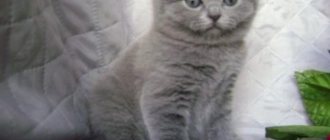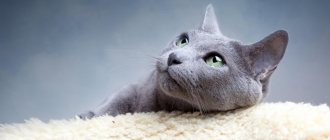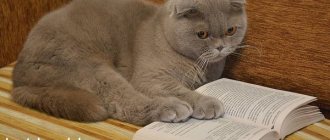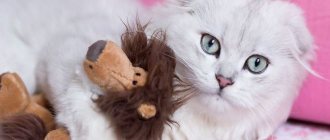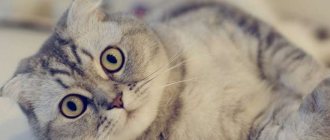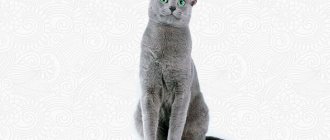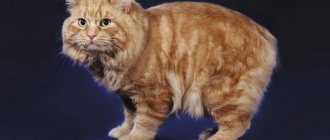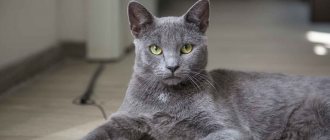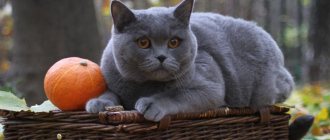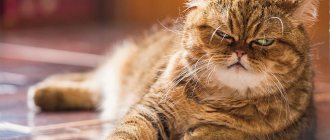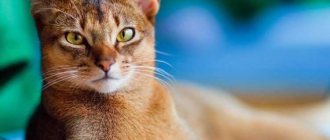- April 17, 2019
- Cats
- Victor Sobolev
The Blue Scottish Fold, otherwise known as the Scottish Fold, is a beautiful breed with a little quirk. Her ears are lowered down, but do not cause any discomfort to the animal. Blue Scottish Fold cats are very beautiful and very popular. As is typical of a true Scot, Scottish Folds are surprisingly calm, intelligent and are able to give their owner irreplaceable comfort in the home. In this article you can learn about the standard of the Scottish Fold cat breed, the characteristics of the animal, its character and possible difficulties.
Breed standard
This is a medium-sized animal, belonging to the short-haired type, with curled ears. Moreover, babies are born with straight ears, but after a few weeks they droop. The coat of a Scottish Fold cat is short and thick, with a pleasant softness to the touch. The body build is dense and powerful. The legs are of medium length, with large pads on the paws. The eye color of blue Scottish Fold cats is usually almond-shaped. In kittens they may be a different color, which will change over time. The weight of the pet varies from 3 to 6 kilograms, depending on gender. The size of the Scottish Fold cat is approximately 28-30 cm.
Beliefs and signs about black cats
In England, where the lineage of fold-eared cats began, the attitude towards black animals is completely different from how they are perceived in eastern countries.
- In Scotland, meeting a black cat is considered a good omen.
- If a black cat enters someone else's house, it means that a happy surprise awaits its owners. This has been believed in the English provinces for many centuries. Therefore, a saucer of milk is often left near the house in case an unfamiliar four-legged guest arrives.
- Black cats are highly prized by British sailors. Since ancient times, such animals have been considered the best rat catchers. For the same reason, farmers selected black cats.
- For the fair sex, a black cat attracts suitors to the house and increases the girl’s chances of a successful marriage.
The black fur of fold-eared cats has not become the subject of a negative reputation for these cats. They look too funny to inspire fear or apprehension when you meet them. With good heredity and proper maintenance, Scots live up to 15 years.
They delight others with their gentle character, good disposition, sociability and impeccable politeness, which is inherent in real Englishmen.
I like3I don't like
Description of the blue Scottish fold cat
As a rule, it is believed that there are practically no incidents with these beautiful creatures. By nature, blue Scottish Fold cats are quite calm and affectionate. As children, they quickly get used to a new place and household thanks to their natural friendliness. They love their owners so much that they are ready to follow them on their heels, while doing so unobtrusively. The Scots have a stable and balanced psyche. They get along well not only with children and animals, but even with strangers. Scottish Fold cats have normal health and cleanliness.
As with any other living beings, there are some problems with the Scots. This usually occurs when the cat is still young and full of energy. Young Scottish Folds are very active and can run around rooms for hours. But adult individuals have a phlegmatic disposition and would rather sit on their owner’s lap than play and run around.
Other breeds of blue screen star cats
“British” and “Scots” are far from the only TV stars.
For example, the face of the advertising campaign for Gourmet Gold food is a white Persian cat, and Sheba is represented by an elegant Russian blue cat. But to become a screen star, you don’t have to belong to any particular breed. The well-known cat Boris from the Kitiket advertisement is a mongrel, just like the ginger cat from the Friskies commercials. Advertising is one of the most important aspects of the success of any brand. But sometimes it brings not only fame to the company, but also an advertising hero. A striking example of this is the Whiskas advertising campaign, which popularized British and Scottish Shorthair kittens. Everyone dreams of having such a pet. The main thing is to accurately determine the breed and color.
Scottish fold cost
The price of a kitten depends on what the future owners plan to get a pet for. For people for whom it is fundamentally important to get a purebred show-class kitten for its subsequent participation in exhibitions, the cost will be at least 50 thousand. If they buy a baby just for the soul and its origin is not so important for the family, then it is quite possible to purchase an animal for between 10-30 thousand rubles. The Blue Scottish Fold cat is a fairly common breed. You can buy it in almost any city.
Primary colors
There are primary coat colors for Scottish cats. Any color of an animal can be classified into one group or another:
- tabby;
- solid (plain);
- chinchilla;
- smoky;
- shaded;
- with a white base;
- colorful (colored);
- tortoiseshells.
These colors are considered the most important for classifying an animal by its color. Each cat of the Scottish breed can be classified into one of the listed groups.
Scottish Straight Color Point
Plain
Another name for this group is solid colors. This type includes monochrome animals with uniform tinting of the coat in one color. Since the British breed was of particular importance when breeding the Scots, the Scottish coat received blue and gray tones, and the color of the iris acquired an amber color. Various variations of genes (dominant, recessive) determined the appearance of different colors of Scots. These can be a variety of shades:
- black or ebony;
- milk chocolate or cinnamon;
- chocolate or brown;
- “deer” – faun;
- red (red);
- soft gray with a pink undertone – lilac;
- pure white.
White Scottish Fold.
A cat's eyes directly depend on the color of its coat. White pets tend to have blue or different colored eyes (heterochromia). Purple and black cats have irises of yellow and copper shades. Amber is typical for individuals of chocolate colors. This type of wool should not be interspersed with any other color. The tone should be rich and uniform along the entire length of the hairs. The presence of marks on the coat means the presence of a defect, which reduces the value of the cat if it takes part in professional felinologist exhibitions.
Cats of this breed, colored pure black, white, red, chocolate, are considered rare. Such kittens will be more expensive. Precious colors - gold and silver - are also considered solid. The task of any breeder is to preserve the purity of the color and its breed type. They are unstable when crossed and are very finicky about adding a new set of genes.
Two-color or bicolor
This term refers to the combination of half the wool is white and the second half can be colored in other colors, for example:
- blue;
- cream;
- red;
- tabby
In the latter case, the pattern must be strictly symmetrical. With this combination, animals can be called cream bicolor or red bicolor.
Blue straight-eared bicolor
Cream bicolor fold
Red bicolor straight
Tabby bicolor fold
Point
The body of the animal has a light basic shade, some areas are painted in darker colors. This is a group of oriental colors (originally found in eastern cat breeds). A similar color is also found in Persian, Fold, Thai and other cat breeds. In turn, color points are divided into subspecies, of which there are 20. There are basic or classic combinations that occur more often than others:
- Seal Point - These cats have a basic white or cream color with dark brown and black spots on the body. In the English version the color is called seal-point.
- Blue point - blue or gray spots on a white-blue background. Other cool shades may occur.
- Chocolate point. The general color of the animal is similar to ivory, and the markings are a brown chocolate shade, but several tones lighter than those of seal points.
- Lilac. Another name for lilac (lilac-point). These cats have spots of brown or gray-pink, lilac, and the body of the animal is light beige.
Interesting read: who are the lop-eared Britons?
Using these colors, breeders created other shades that are now widespread. Such derivatives are:
- cream points – soft cream-colored spots on the cat’s body located on white fur;
- red - red spots on a light body (sometimes pure white);
- Torti – similar to tortoiseshell. The main feature is that it occurs in females. The markings are heterogeneous and can be in the form of a mix of spots of brown, red, cream, and blue. Another feature is that their shade changes with age;
- tabby - the markings are striped, the colors may vary, and the body is predominantly light.
There are also rare points that are considered exotic:
- Cinnamon Point - Markings are cinnamon colored on a beige body. The skin on the pads is light pink;
- faun - light purple markings located on the beige body of the animal.
It is characteristic of all points that the color depends on the animal’s body temperature (in the cold, the colored areas become a little darker and more saturated). Breeders are constantly working with this group to create more interesting marking colors.
Torties or tortoiseshells
Tortoiseshell, also called tortoiseshell, is similar to the coloring of a turtle's shell. Such cats have an interesting pattern on their body, similar to this reptile. This coloration can be unpredictable and may change. This happens after every molt, which occurs twice a year. In this case, the design, pattern, and color of the marks may change. Individuals with this color are almost always sterile and are found only in cats.
Cats with such fur are extremely rare. The color scheme is usually formed by combinations of red, black, and cream colors. Individuals with a color distribution proportion of 1:1:1 look most impressive. There are several features of this color:
- In blue tortoiseshell cats, black can be replaced by blue, red by cream. This creates a bluish-cream combination.
- Purple is replaced by black and red, and cream by purple.
- Chocolate turtles have a black to chocolate substitution.
There are a variety of combinations. The main requirement is a symmetrical, uniform pattern throughout the animal's body.
Smoky
This type is also called smoky or smokey (from the English “smoke” - smoke). Such a cat should have a uniform color without inclusions. The base is silver-white wool. Part of the hair is black, the rest is silver. This type belongs to the silver group. This phenomenon is formed by the dominant gene of this color.
Smokey should not have a pattern, but this can sometimes happen. It can be perceived as a solid (solid) color, but this is wrong. The animal's hair is colored 2/3 of its length and is called shaded. If your pet has thick fur, you need to part the fur to see the color of the base.
Tabby
The animal may have eyeliner on the nose, eyes, a pattern on the chest that resembles a necklace, rings on the tail, paws, spots on the ears or cheeks. There may be a line around the nose. The stripes on the body should not be wide. Marbled species may show a gradual transition to spots on the belly or neck. This pattern stands out against the general background of the pet’s color. There are different tabbies:
- Tiger or mackerel. Such animals may have narrow stripes directed vertically. A pattern resembling a collar appears on the neck. The side stripes rise up the back, forming a saddle-like pattern here.
- Spotted or spotty. Spots of various shapes and sizes have clearly defined boundaries. A line is formed along the entire length of the spine.
- Shaded, whiskey or marble. The pattern consists of spots and stripes that are scattered over the entire surface of the animal. Such animals can have any coat color, the main thing is that they have a pronounced pattern against the general background. It owes its name to its similarity to this textured stone.
Tabby Scottish fold.
Tabbie can also be classified by color:
- Silver. It is the main one, on which a black pattern is applied.
- Silvery blue. The undercoat is white on the sides, face and tail of the animal.
- Reds. Red base with rich red patterns.
- Brown. The wool has a dark copper color, on which a black pattern is drawn.
- Blue. Refers to cream and blue tones. The pattern is expressed against the general background.
- Cream. The base of the wool is light, the pattern contrasts against its background.
- Cameo. White base with red stripes.
This coloration suggests the presence of a zonal pattern on the body. It can be in the form of the letter “M”, which is located on the animal’s forehead.
Paticolor
Characterized by the appearance of white spots of different sizes and shapes. It could even be a white cat with a few spots of a different tone. Two options are considered standard, there are eight in total. The ideal is 1/3 to ½ white. If a cat has more than 90% of its entire surface painted white, the color is called “harlequin”. If an animal has a colored tail, then it is a van.
Scottish Fold Paticolor.
Chinchilla
The basis of this color is tipping. This phenomenon is characterized by the coloring of 1/8 of the hair, most of which is white. A kitten gets this color if both of its parents are colored in the same way. There are three main types of chinchilla:
- golden;
- blue;
- unique.
Silvers may have stripes or shadow marks on their tail. The eyes are green and the nose is beige. The golden chinchilla is characterized by the presence of a reddish tint on the back, sides, and tail.
Ticked
This color is considered rare for this breed; kittens with a similar color are highly valued. The peculiarity lies in the color of the hairs. The hair should have three stripes of different colors. Also, such cats are sometimes called Abyssinian. This creates the image of small specks on the animal’s fur. There may be stripes on the paws and tail.
Interesting read: what to feed the Scots.
Shaded
The coloring extends to the upper third of the hair. The rest of the body is painted white. Such individuals have a light undercoat. The coat is shaded on the sides, back, and head. Golden, silver, and red colors can also be shaded.
Wang
White body except for tail and muzzle. There may be several spots on the animal's body and paws. Their coat is unevenly colored and looks like a tabby.
Harlequin
4/5 of the wool is dyed white. The spots are scattered randomly over the entire surface.
Shaded
ticked
Harlequin
Wang
Cameo
brindle
Blue Scottish Fold cat: care and maintenance features
The little Scottish Fold is a real livelier, bursting with energy. When a new family member arrives, you will need to buy the following supplies for his comfortable living in the house:
- two bowls - for food and drink;
- toys - to distract the baby’s attention and not play with him with his hands;
- scratching post;
- combing brush;
- tray;
- basket or sleeping mat.
Before the kitten arrives, you should remove all objects that are dangerous to it: sockets, wires and small things that it could accidentally swallow.
The house must be clean so that the little fragile creature does not get sick.
Keeping a blue Scottish Fold cat will cost owners no more than any other breed.
It's easy to care for. To keep the fur looking neat, it is enough to brush your pet two to three times a week. During the molting period, the procedure is carried out more often.
Ears, eyes and nose should always be clean. If any discharge appears, it should be removed immediately using a cotton pad soaked in water. You need to bathe your cat no more than once every six months.
To the peculiarities of caring for a blue Scottish fold cat, we can add that these creatures are sometimes susceptible to diseases of the joints, eyes and skin. For this reason, you need to closely monitor the animal.
What to name a Scottish kitten
Many new owners of plush kittens prefer to follow the beaten path and give their pets well-known nicknames: Barsik, Murzik, Vaska. But for open-minded cat lovers, choosing a name for a boy or girl is a great way to show creativity and imagination.
What nickname can you come up with for your pet so that it is associated with Scotland? This is not difficult, because the history and culture of this country are known throughout the world. Kilt, bagpipes, whiskey, tartan - this is not a complete list of words that make us think of distant Scotland.
You can rack your brain and come up with a name based on the suggested words. But most often male kittens are named Scott (Scotty), Shot (Shotti), Valli, Rob, Roy, Baxter, Archie and even Holmes or Watson. The girls are called Foxy, Orange, Athena, Shakira, Martha, Chessie, Shaddy.
What should you teach your cat?
All pets must be trained to a certain discipline. A cat is not a dog, and it is unlikely that it will unquestioningly follow commands to please its owner. But even such an independent and freedom-loving creature must know the norms of behavior - what can be done and what cannot be done.
Thanks to their high intelligence and quick wit, blue Scottish Fold cats grasp everything literally on the fly, and raising an exemplary pet who will fill life with only joyful moments will not be difficult.
So, what should a domestic cat know and be able to do?
Sharpen your claws only on a scratching post
Claws are an important attribute of any cat. With their help, the animal climbs trees and other surfaces, and also uses them as a means of defense. Sharpening claws, doing a kind of manicure, is a natural need for a pet. Unknowingly, cats begin to tear up everything that gets in their way: furniture, carpets, wallpaper. To avoid this, you need to accustom your pet to order. Every time a cat starts sharpening its claws in an inappropriate place, immediately pick up the animal and bring it to the scratching post. This needs to be repeated several times. Gradually, the animal learns to sharpen its claws where it is needed.
Pet health
In general, cats of this breed have good health, but are sometimes susceptible to certain diseases. Often, pets suffer due to improper mating when Scottish Folds are mated with each other, which is absolutely forbidden to do. The list of common diseases includes:
- entropion of the eyelid;
- allergy;
- deafness.
In addition to the above diseases, Scots in adulthood have problems with the digestive tract and the functioning of the cardiovascular system. To avoid them, you need to monitor your pet’s condition and take him to the veterinarian more often.
Breed card
| Characteristics of a cat | Notes | |
| General information | Reminiscent of British Shorthair cats. Unmistakable appearance thanks to the floppy ears | Folds and straights are born with ordinary straight ears, and only by the third week it becomes completely clear which is which |
| Character | Affectionate, calm, but still more active than the British breed | Easily adapt to a new place of residence and survive trips calmly |
| Appearance | Characteristic folded ears, round muzzle. Among the colors, bicolors are more common than others. They are a short-haired breed | It used to be believed that due to the unusual structure of the ears, kittens were often born deaf, but this is not true. |
| Behavior at home | Calm cats love to sleep on their backs with their paws spread out, or sit in funny positions | Treat children and other pets well and are not jealous |
| Care | Brush 1-2 times a week, more often during shedding | |
Clean your ears, as earwax accumulates more quickly
| Health problems | Folds cannot be crossed with each other due to the genetic transmission of bone and joint problems. The fold's partner must have straight ears, such Scots are called Scottish Straight | Scottish Straights have relatively recently become an independent breed. |
What to feed?
To keep your pet happy and healthy, you need to carefully monitor its diet. If the owner plans to feed the cat natural food, then his diet should include the following products:
- meat (beef, turkey, veal);
- boneless fish;
- offal (boiled);
- vegetables;
- eggs.
It is not recommended to feed cats raw, unprocessed meat to avoid infection with helminths. Also, do not give your pet milk. It is useful only for small kittens, but not for adult animals.
Products prohibited for cats include:
- sweets;
- alcohol;
- fatty and fried foods;
- smoked meats
Such food is not only not healthy for the animal, but can also have a detrimental effect on its health and body function.
If the owner decides to feed the pet prepared food, then preference should be given to well-known premium companies, such as Royal Canin or Purina. Scottish Folds happily eat both wet and dry food.
Your cat should always have a bowl of clean, fresh water.
Difficulties with Scottish Folds
Scottish Folds are peaceful and affectionate creatures. They love their owner and all family members. There are no particular difficulties with keeping Scottish cats. In childhood, kittens are overly active and can cause some trouble for household members, but with age, the playful baby turns into an important and phlegmatic cat. Fold-eared cats are perfect for families with children and for retirees, but they definitely won’t fit into the environment of people who lead an active lifestyle. Scots shed actively several times a year, and during this period you will have to clean more often. Another problem with keeping a blue fold cat is its insatiable appetite. Especially in castrated and neutered animals. To prevent your pet from gaining excess weight, you need to control your food intake.
In general, turning a blind eye to some difficulties, we can say that the Scottish Fold is a wonderful pet.
Scottish cat color chart
Cats of the Scottish breed (Scottish Fold, Highland Fold, Scottish Straight and Highland Straight) are subject to the international color classification. It has symbols - numbers and letters. The code consists of:
1. Capital letters denoting the breed.
2. Lowercase letters indicating the primary color (blue, chocolate, etc.).
3. Pairs of numbers indicating the type of color (shaded, harlequin, Siamese, etc.) are numbers from 1 to 35.
4. Tail length - numbers from 51 to 54.
5. Eye color - numbers from 61 to 67.
6. Another additional pair of numbers can indicate the shape of the ears - 71 (straight ears of the Scottish Straight) and 73 (dropping and forward-curved ears of the Scottish Fold).
XXX.xx.NN.NN.NN.(NN)
xx - lowercase letter color designations:
| Designation | Colors |
| A | blue |
| b | chocolate, brown, chestnut (chocolate, brown, Havana, champagne) |
| With | lilac, lavender (lilac, lavender, platinum) |
| d | red, flame (red) |
| e | cream (cream) |
| f | tortoiseshell, patch (tortoiseshell) |
| g | blue-cream, blue-tortie (blue cream, blue tortoiseshell) |
| h | chocolate-tortie (chocolate tortoiseshell) |
| j | lilac-tortie (lilac tortoiseshell) |
| n | black, ebony, seal, sable, ruddy (black, ebony, seal, sable, wild) |
| o | sorrel, cinnamon, honey (sorrel, cinnamon, honey) |
| p | beige fawn (yellow-brown, beige) |
| q | sorrel tortie (red-brown tortoiseshell) |
| r | beige fawn tortie (beige tortoiseshell) |
| s | silver, smoke (silver, smoky) |
| w | white (white) |
| x | unregistered (unregistered color) |
| y | golden (golden) |
NN.NN.NN.(NN) - values of pairs of digits (up to three main and one auxiliary), starting with 0:
| Designation | Decoding |
| 01 | van (van) |
| 02 | harlequin (harlequin) |
| 03 | bicolour (two-color, bicolor) |
| 04 | mitted/white point (with white markings for color points) |
| 09 | little white spots (white spotting 1-2 cm) |
starting with 1:
| Designation | Decoding |
| 11 | shaded (shaded, i.e. 1/4 of the top part of the hair is darkened) |
| 12 | tipped, shell (veiled, i.e. 1/8 of the top part of the hair is darkened) |
starting with 2:
| Designation | Decoding |
| 21 | tabby, agouti (striation, agouti factor) |
| 22 | blotched, marble |
| 23 | mackerel, tiger (mackerel, tiger) |
| 24 | spotted (spotted) |
| 25 | ticked (ticked or Abyssinian) |
starting with 3:
| Designation | Decoding |
| 31 | burmese (Burmese) |
| 32 | tonkinese (Tonkinese) |
| 33 | himalayan or siam (Himalayan, Siamese, point) |
| 34 | singapura (Singaporean) |
| 35 | abyssinian (Abyssinian) |
starting with 6 (eye color):
| Designation | Decoding |
| 61 | blue |
| 62 | yellow, golden (yellow, orange, golden) |
| 63 | oddeyed |
| 64 | green |
| 65 | burmese (eye color of Burmese cats) |
| 66 | tonkinese (eye color of Tonkinese cats) |
| 67 | himalayan or siam (eye color of Himalayan and Siamese cats) |
For example, a fold-eared cat of color ps 24 is a cat of silver spotted fawn color. Thus, as you can see, the color code is formed from letters and numbers, but there are a lot of variations in the colors of Scottish breed cats, because... various factors combine to form countless variations. Within the scope of this article it is impossible to show absolutely all the colors of Scottish cats, cats and kittens.
Owners' opinion
Owners of Scottish Folds often leave comments about their pets. Most owners speak positively about their favorite plush cats. As a rule, they are balanced, intelligent and beautiful. The Scots are kind to all people and animals. But owners often write about problems associated with this breed. These include high activity of the pet at a young age, disobedience, ignoring family members, damage to furniture and fragile health.
Often, most of the problems that a cat creates are the fault of the owner himself, who did not react in time and did not show the pet how to behave correctly. When it comes to health, you need to carefully monitor the condition of the animal and not leave the situation to chance.
Scottish Folds are the smartest and most graceful creatures that, with proper training and care, will be excellent pets.
